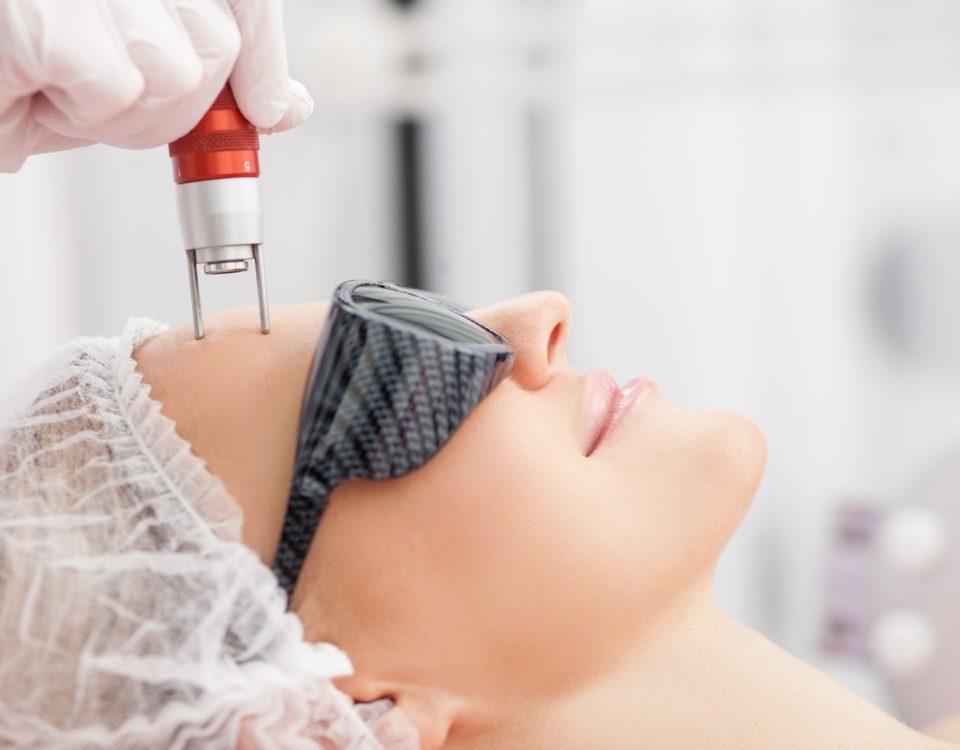
Laser Resurfacing vs. Chemical Peels: Pros and Cons
September 9, 2025
Understanding Fractional Laser Technology: Benefits and Applications
October 27, 2025When it comes to rejuvenating your skin, reducing wrinkles, or addressing scarring and other imperfections, modern technology offers a variety of treatments. Two popular options that patients often consider are NanoFractional RF (Radio Frequency) and traditional laser treatments. Both methods are effective, but they work differently, have different recovery experiences, and suit different skin types and concerns. Understanding how each treatment works can help you make a decision that aligns with your goals, lifestyle, and skin needs.
What is NanoFractional RF?
NanoFractional RF is a minimally invasive treatment that uses radio frequency energy to stimulate the skin’s natural healing process. Tiny pins create controlled micro-injuries on the surface of the skin, which encourages your body to produce more collagen and elastin. Over time, this results in smoother, firmer skin with improved texture.
This treatment is particularly effective for mild to moderate wrinkles, fine lines, acne scars, and enlarged pores. Because it doesn’t rely on light energy or pigment absorption, NanoFractional RF is safe for all skin types and tones, making it a versatile option for many patients. Another benefit is the minimal downtime. Most people experience slight redness or tiny scabs, which typically fade within a day or two, allowing them to return to their daily routine quickly.
What Are Traditional Laser Treatments?
Traditional laser treatments use focused light energy to target specific layers of the skin. There are two main types of lasers: ablative and non-ablative. Ablative lasers remove a layer of skin to stimulate deep regeneration, making them ideal for more severe wrinkles, scars, and sun damage. Non-ablative lasers work beneath the skin’s surface, stimulating collagen production without removing the top layer of skin.
Laser treatments are very effective for resurfacing the skin, addressing pigmentation issues, and correcting deeper scars. However, some lasers can be more sensitive to darker skin tones, increasing the risk of hyperpigmentation. Recovery time varies depending on the type of laser. Non-ablative lasers often require minimal downtime, while ablative lasers may necessitate a week or more of recovery as the skin heals.
How the Treatments Differ
One of the main differences between NanoFractional RF and traditional lasers is the way they interact with the skin. NanoFractional RF uses heat from radio frequency, which penetrates the deeper layers of skin while sparing the surface from significant damage. Traditional lasers rely on light energy, which targets water, pigment, or blood vessels depending on the laser type. This distinction affects safety, especially for those with darker skin tones.
Another key difference is the recovery experience. NanoFractional RF typically offers quicker recovery, with mild redness or small scabs that fade in a day or two. Traditional lasers, especially ablative types, often involve peeling, redness, and sensitivity that can last a week or more. Your lifestyle and schedule may play a big role in choosing between the two.
What Skin Concerns Do They Address?
Both NanoFractional RF and traditional lasers can improve skin texture and reduce signs of aging, but some concerns respond better to one treatment over the other. NanoFractional RF is ideal for fine lines, mild wrinkles, mild scarring, and enlarged pores. It also helps improve skin firmness and elasticity, making it a great choice for overall skin rejuvenation.
Traditional lasers excel at more intensive treatments. Ablative lasers are particularly effective for deep wrinkles, significant scarring, and pigmentation issues. Non-ablative lasers are good for moderate skin concerns, but may require several sessions to achieve the desired results.
Pain and Comfort
Most people tolerate NanoFractional RF well. Some report a mild tingling or stinging sensation during treatment, but topical numbing creams are typically applied to minimize discomfort. Traditional laser treatments vary in intensity. Ablative lasers can be more uncomfortable, sometimes requiring stronger topical anesthetics or sedation, while non-ablative lasers are generally more comfortable but can still produce a mild stinging sensation.
Number of Treatments and Longevity
NanoFractional RF generally requires one to three sessions spaced a few weeks apart. Many patients notice improvements after the first treatment, with optimal results appearing after the series is complete. Maintenance treatments help prolong results over time.
Traditional laser treatments vary depending on the type and severity of skin concerns. Ablative lasers may achieve dramatic results in just one session, whereas non-ablative lasers often require multiple treatments over several weeks or months to achieve similar improvements.
Cost Considerations
The cost of treatments depends on several factors, including location, provider expertise, and treatment area. NanoFractional RF is often more affordable per session than ablative lasers and may require fewer treatments. Traditional laser treatments, especially ablative options, tend to be more expensive due to the intensity of the procedure and the dramatic results achieved in fewer sessions. Non-ablative lasers are usually moderately priced but require multiple treatments, which can add to the overall cost.
Choosing the Right Treatment for You
Deciding between NanoFractional RF and traditional laser treatments comes down to your skin type, concerns, lifestyle, and goals.
- If you have darker skin or are concerned about hyperpigmentation, NanoFractional RF is generally safer.
- If you want dramatic results for deep wrinkles, scars, or pigmentation issues, traditional lasers may be the better choice.
- If minimizing downtime is important, NanoFractional RF offers faster recovery.
- Consider your comfort level with potential pain and recovery when choosing a treatment.
It’s always best to consult with a board-certified dermatologist or licensed aesthetic provider. They can evaluate your skin, understand your goals, and create a customized treatment plan that balances results, safety, and convenience.
Combining Treatments
In some cases, a combination approach may provide the best results. For example, NanoFractional RF can be used to improve texture and firmness, while non-ablative lasers address pigmentation issues. A customized treatment plan can maximize results while minimizing downtime.
Making the Right Choice for Your Skin

Both NanoFractional RF and traditional laser treatments are powerful tools for improving skin health and appearance. NanoFractional RF is versatile, minimally invasive, and suitable for nearly all skin types, while traditional lasers, particularly ablative types, provide dramatic results for more severe concerns. Your choice should reflect your skin type, desired outcomes, and personal preferences. By understanding the benefits, limitations, and recovery experiences of each treatment, you can make an informed decision and achieve healthier, smoother, and more radiant skin. For a free consultation on skin treatments, contact Spa MD today.
New Clients:
$35 deposit for all new clients
Cancellation/No Show Policy:
$35 fee for all no show, no call and any cancellations less than 24hrs before the start of your appointment.Any prepaid services will be forfeited.
Call us at +1(651)222-4490
Email us at SpaConsultantsMD@gmail.com
or, Schedule a free consultation
We are located on the main level inside of the Blair Arcade Building. We validate parking in the lot connected to the building off of Selby. Be sure to bring your ticket in with you!
Business Hours:
Monday: 9:00am - 8:00pm
Tuesday: 9:00am - 5:00pm
Wednesday: 9:00am - 8:00pm
Thursday: 9:00am - 8:00pm
Friday: 10:00am - 5:00pm
Saturday: 9:00am - 2:00pm (3 Saturdays per month- please call or email for more information)




